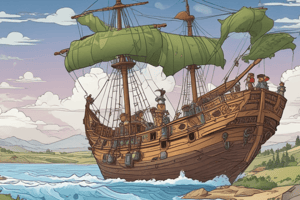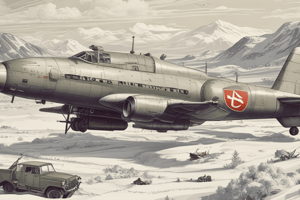Podcast
Questions and Answers
Who is known for producing a series of cartoons depicting the head of the king as a pear?
Who is known for producing a series of cartoons depicting the head of the king as a pear?
Charles Philipon
In 1840, what new meaning did the word 'cartoon' assume?
In 1840, what new meaning did the word 'cartoon' assume?
Humorous drawings
Who is credited with creating the first picture to officially be called a 'cartoon' in 1843?
Who is credited with creating the first picture to officially be called a 'cartoon' in 1843?
John Leech
Who is often considered the first political cartoonist in Britain?
Who is often considered the first political cartoonist in Britain?
Which artist is regarded as the 'father of caricaturing and animation'?
Which artist is regarded as the 'father of caricaturing and animation'?
What type of comic art became popular in the 20th century, characterized by jokes without words, often in multiple frames?
What type of comic art became popular in the 20th century, characterized by jokes without words, often in multiple frames?
Who is known for his cartoons of U.S. Civil War that appeared in Harper's Weekly?
Who is known for his cartoons of U.S. Civil War that appeared in Harper's Weekly?
What types of advancements facilitated the growth of cartooning and caricaturing?
What types of advancements facilitated the growth of cartooning and caricaturing?
What is the Italian origin of the word 'cartoon', and what does it mean?
What is the Italian origin of the word 'cartoon', and what does it mean?
How does a cartoon differ from an illustration or sketch in terms of storytelling?
How does a cartoon differ from an illustration or sketch in terms of storytelling?
What were 'cartoons' initially used for by Italian painters, before the modern use of the term?
What were 'cartoons' initially used for by Italian painters, before the modern use of the term?
What is the origin of the word 'caricature', and what does the term refer to?
What is the origin of the word 'caricature', and what does the term refer to?
Before the modern understanding of ‘cartoon’, what was the general term used for humorous drawings?
Before the modern understanding of ‘cartoon’, what was the general term used for humorous drawings?
Which school and artists are credited with originating the concept of modern caricaturing at the end of the 16th century?
Which school and artists are credited with originating the concept of modern caricaturing at the end of the 16th century?
Who was the first artist credited with mass producing cartoons that criticized the social issues of that time?
Who was the first artist credited with mass producing cartoons that criticized the social issues of that time?
What technological development contributed to the spread of William Hogarth's caricatures and criticisms?
What technological development contributed to the spread of William Hogarth's caricatures and criticisms?
Flashcards
Caricature
Caricature
A type of drawing often used in satire that exaggerates physical features to make a point or make someone look ridiculous.
Cartoon
Cartoon
A humorous drawing, often with a caption, that can be used for social commentary or to illustrate a news story. It often uses exaggeration and satire.
Political Cartooning
Political Cartooning
The use of cartoons to criticize social issues or political figures.
One-line-joke
One-line-joke
Signup and view all the flashcards
Development of Cartooning
Development of Cartooning
Signup and view all the flashcards
Influence of Tech on Cartoons
Influence of Tech on Cartoons
Signup and view all the flashcards
Cartoons as Comic Relief
Cartoons as Comic Relief
Signup and view all the flashcards
Dynamic Cartoons
Dynamic Cartoons
Signup and view all the flashcards
What is the origin of the word 'cartoon'?
What is the origin of the word 'cartoon'?
Signup and view all the flashcards
Where are cartoons commonly found?
Where are cartoons commonly found?
Signup and view all the flashcards
What was the term for humorous drawings before 'cartoon'?
What was the term for humorous drawings before 'cartoon'?
Signup and view all the flashcards
What is 'caricature'?
What is 'caricature'?
Signup and view all the flashcards
Where did modern caricaturing originate?
Where did modern caricaturing originate?
Signup and view all the flashcards
Who was a pioneer of mass-produced cartoons for social commentary?
Who was a pioneer of mass-produced cartoons for social commentary?
Signup and view all the flashcards
What advancements made the spread of cartoons possible?
What advancements made the spread of cartoons possible?
Signup and view all the flashcards
How do cartoons differ from illustrations?
How do cartoons differ from illustrations?
Signup and view all the flashcards
Study Notes
Cartooning Historical Background
- Cartoon originated from the Italian word "cartone," meaning cardboard paper.
- Cartoons are humorous or satirical pictorial sketches, often published in magazines, periodicals, or newspapers.
- Cartoons address socio-economic or political issues.
- Cartoons are distinct from illustrations or sketches; they tell a story and appear in periodicals.
- Initially used by painters as preliminary drawings for larger artworks (e.g., tapestries, frescoes).
Caricature
- Caricature derives from the Italian "caricatura," meaning "loaded portrait."
- Caricatures exaggerate physical features for humorous effect.
- Before the modern sense of "cartoon," humorous drawings were often called caricatures.
- Early examples of caricaturing include works by Leonardo da Vinci and artists of the Carracci school.
- Key figures like Annibale and Agostino Carracci contributed to the development of caricaturing.
Cartooning's Evolution
- William Hogarth was an early important political cartoonist.
- Honore Daumier is considered a pioneer of caricature and animation in social commentary.
- 19th-century developments in printmaking and printing spread cartoons' influence.
- Charles Philipon was a key caricaturist for comic periodicals.
- Leone Ghezzi was another significant 19th-century caricaturist.
- The term "cartoon" began to also refer to humorous drawings in the 1840s.
20th Century Cartooning
- World War I influenced political cartooning, with increased bias and comic relief in depictions.
- The development of "one-line-joke" and "pictorial-joke" cartoons was key in the first half of the 20th century.
- Cartoon styles evolved, drawing influence from European styles.
- Thomas Nast was a prominent American cartoonist who illustrated the Civil War.
- Advances in printing and the computing system supported the growth of cartooning.
Studying That Suits You
Use AI to generate personalized quizzes and flashcards to suit your learning preferences.




